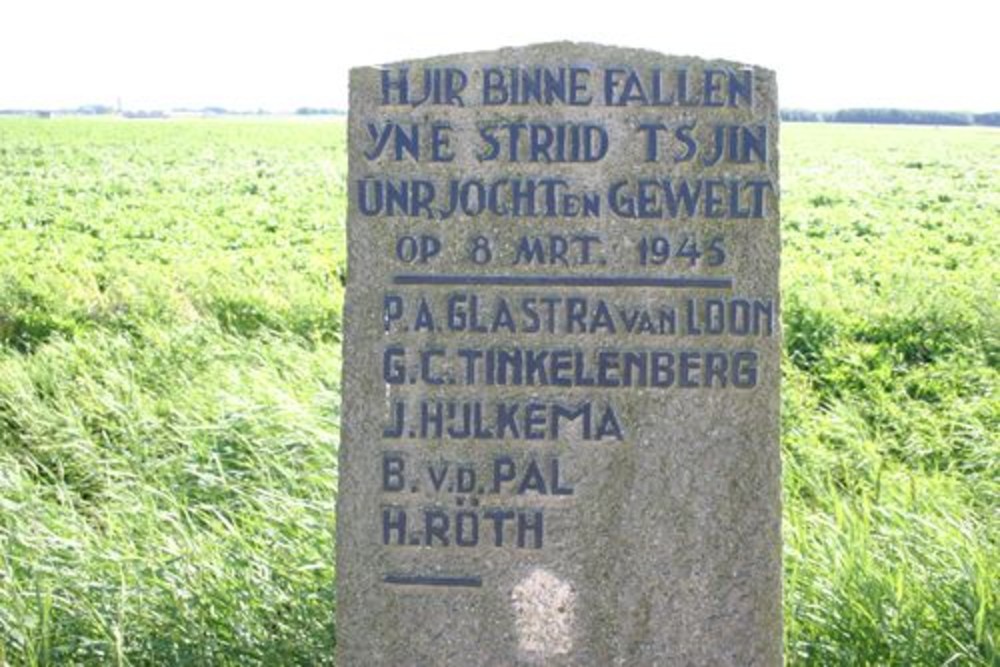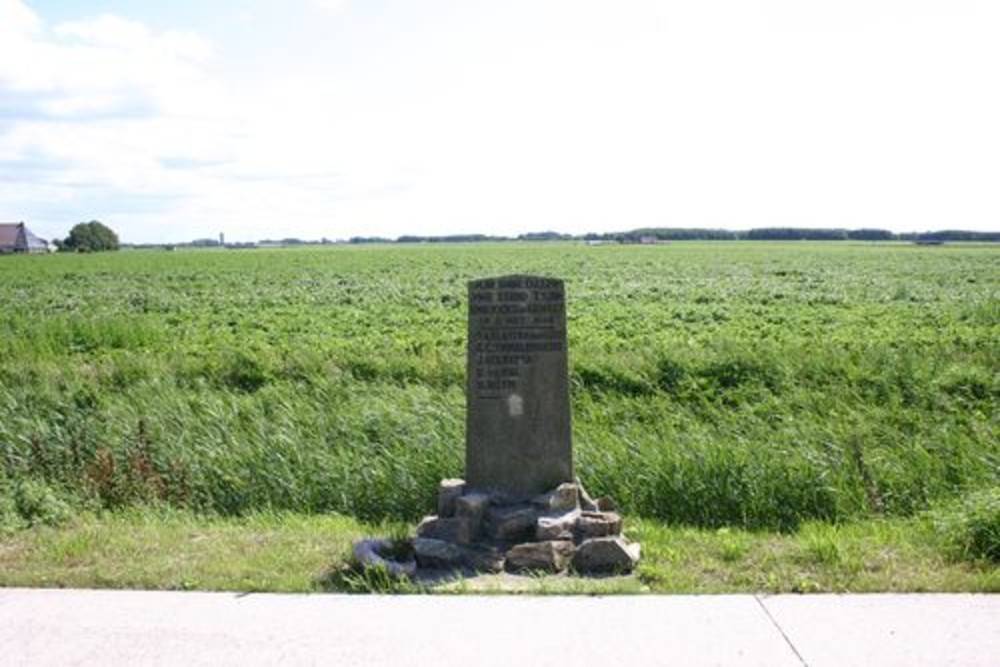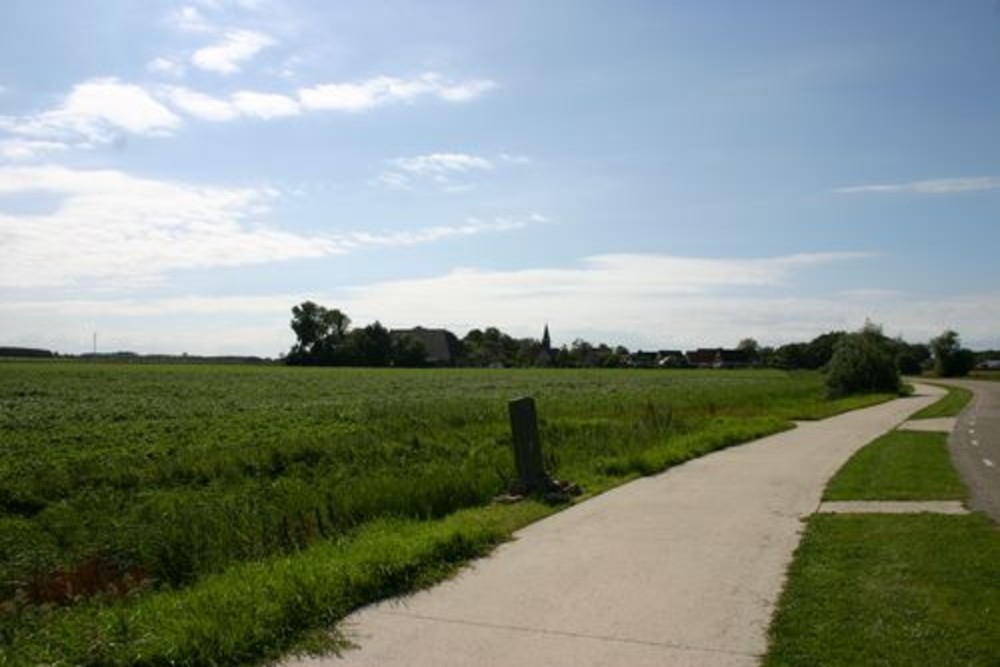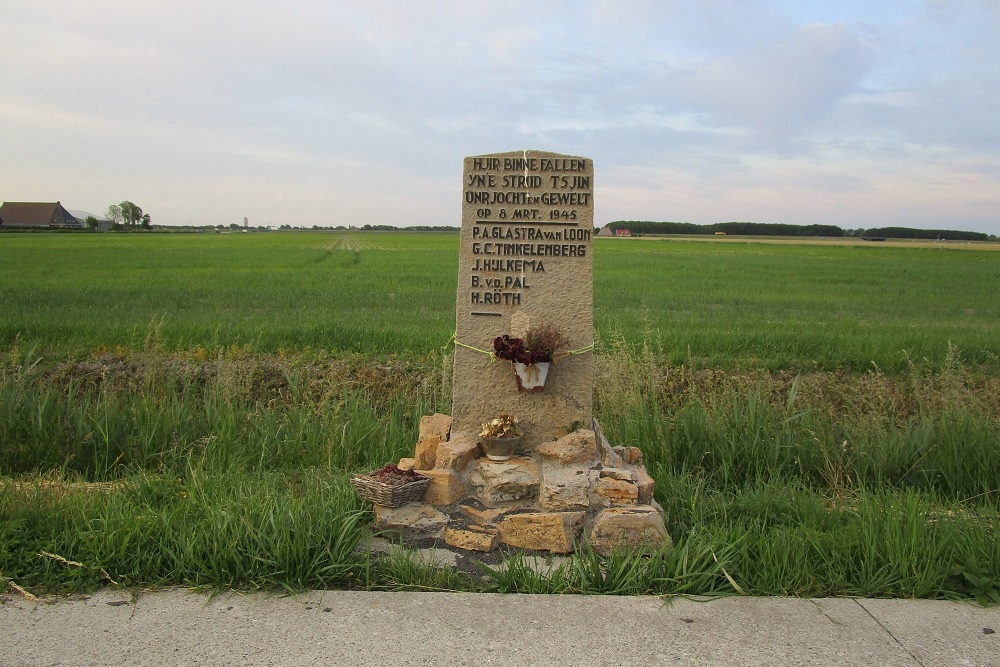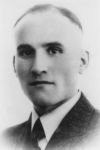Execution Monument Riedsterweg
The war memorial in Dongjum was erected in memory of five fellow citizens who were shot here on March 8, 1945 by the occupying forces.
The names of the five victims are:
PA Glastra van Loon, J. Hijlkema, B. van der Pal, H. Röth and G.C. Tinkelenberg.
The execution was a reprisal measure for the attack on Grietje Sinnema, the interpreter and secretary of the staff of the 'Abteilung für Ernährung und Landwirtschaft' in Franeker. This 19-year-old farmer's daughter from Ried arranged the horse receivables and hay deliveries for the German Wehrmacht for this agency. The fanaticism with which Sinnema set to work eventually led to the farmers complaining to Folkert de Jong, district operations leader of the Dutch Interior Forces (NBS) in Franeker. Due to the horse advances, the arable land could not be worked for the coming harvest. Resistance member De Jong shadowed Sinnema for two weeks to ensure that a possible liquidation was justified. On March 3, 1945, the attack was committed by two members of the NBS. However, Grietje Sinnema was not fatally hit. She was taken to the German hospital in Leeuwarden, where surgery was performed. Sinnema's boss urged retaliation. Five men were then taken out of prison and shot dead at the site of the attack. The lifeless bodies had to remain under police guard for 24 hours, as a deterrent to the villagers. The victims were buried the next day and after the liberation they were reburialed in their own village. Grietje Sinnema returned to her village on April 12, where she was arrested five days later (Friesland had already been liberated).
Pieter Anne Glastra van Loon was born on January 29, 1913 in Rinsumageest. He was a teacher at the Scharnegoutumer school for Christian Folk Education. During the occupation years he joined the National Organization for help to people in hiding in the municipality of Wymbritseradeel and, together with other resistance members, committed a raid on the town hall of Baarderadeel in Mantgum. Eventually he had to go into hiding on the farm of the Bouma family on the Leeuwarderstraatweg in Scharnegoutum, where the Sicherheitspolizei raided on 8 February 1945. Weapons and explosives were found in the yard. The farmer, his two sons and a person in hiding were arrested, but Glastra van Loon and his mate Heinrich Röth managed to hide in a hollow space above a cupboard. When they came out of hiding four days later, they were arrested.
Jacob Hijlkema was born on November 22, 1900 in Grouw. In 1940 he was deputy director of N.V. Halbertsma's factories. In 1944, as a member of the resistance, he became municipal commander of the Dutch Interior Forces. On Saturday, March 3, 1945, he was arrested by the Grüne Polizei for possession of weapons. Hijlkema was transferred to the Burmaniahuis in Leeuwarden with five other resistance fighters from the municipality of Idaarderadeel. He was buried at the General Cemetery in Grouw.
Bauke van der Pal was born on August 4, 1918 in Joure. In 1942 he joined the resistance movement in Grouw. He did courier services and organized arms transports. On March 3, 1945 he was arrested and transferred to the prison in Leeuwarden at the same time as Jacob Hijlkema. Van der Pal was buried at the General Cemetery in Grouw.
Heinrich Röth was born on May 12, 1913 in Ratingen (Germany). The textile technician was living in Enschede when he received a call to join the German Wehrmacht. But Röth was a fierce opponent of the National Socialists and went into hiding with the cattle farmer Hessel Bouma in Scharnegoutum, where Glastra van Loon had also found shelter. Here they were arrested on February 8, 1945.
George Christiaan Tinkelenberg was born on August 31, 1901 in Hoorn. He was a teacher in Zierikzee and became head of the public school in Sijbrandaburen. As a former officer of the Dutch army, he was asked to take charge of the 9th district of the Dutch Interior Forces. He performed his resistance work under the pseudonym 'Schuman'. On February 8, 1945, the Grüne Polizei carried out a raid in the Lege Geaën, the region between Sneek and Rauwerd. Tinkelenberg was arrested along with five other men and transferred to Crackstate prison in Heerenveen. Tinkelenberg was buried at the N.H. cemetery in Sijbrandaburen.
Do you have more information about this location? Inform us!
Source
- Text: Bert Deelman
- Photos: Bert Deelman (1, 2, 3), Dick de Bruijne (4)
- Nationaal Comité 4 en 5 mei
- SLOOTS, H., Het meisje dat dood moest, Uitgeverij Elikser, Leeuwarden, 2022.
- STAVAST, P.J., Vlucht en verzet, Friese Pers Boekerij bv, Leeuwarden, 1983.
Nearby
Point of interest
Monument
- War Memorial Protestant Church Churchyard Dongjum - Dongjum
- Memorial Reformed Church - Franeker
- Franeker Reflection Monument - Franeker
Cemetery
- Commonwealth War Grave Protestant Churchyard Dongjum - Dongjum
- Dutch War Graves Municipal Cemetery Franeker - Franeker
- Commonwealth War Graves Municipal Cemetery Franeker - Franeker
Remembrance Stone
- Memorial Stone on Dutch Churchyard Dongjum - Dongjum
- Stumbling Stone Buorren / It Dok parking - Berlikum
- Stumbling Stone De Kamp 7 - Berlikum
Fortification
- Radio Bearing Station Löwenzahn I Franeker - Franeker
- German Bunker Koehoal Tzummarum - Tzummarum
- Radio Bearing Station Löwenzahn II Menaam - Menaam
